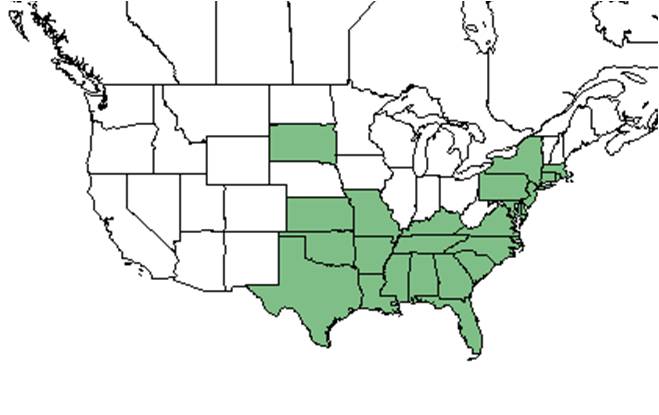Difference between revisions of "Ptilimnium capillaceum"
KatieMccoy (talk | contribs) |
KatieMccoy (talk | contribs) |
||
| Line 26: | Line 26: | ||
==Ecology== | ==Ecology== | ||
===Habitat=== <!--Natural communities, human disturbed habitats, topography, hydrology, soils, light, fire regime requirements for removal of competition, etc.--> | ===Habitat=== <!--Natural communities, human disturbed habitats, topography, hydrology, soils, light, fire regime requirements for removal of competition, etc.--> | ||
| + | In the Coastal Plain in Florida and Georgia, ''P. capillaceum'' has occurred in wiregrass/slashpine communities; the edge of a small cattail swale; mucky soils of floodplains; dry pond in a coastal hammock; cabbage palm hammocks; scrubby flatwoods adjacent to cypress swamps; slough edges; wet ditches bordering flatwoods; borders of salt flats; wet sands near a salt marsh; gum depressions; low depressions amongst sand dunes; middle of a lake growing on a tree stump; and cypress-sweetgum floodplains. It has also been observed in disturbed areas such as roadsides, a grazed cabbage palm hammock, moist roadside ditches, along railroad beds, marsh in a drainage canal bordering a swamp forest, permanently flooded pits, drained clearing of a wet hammock, exposed peat beneath pond cypresses ringing a lake after draining, and powerline transects across pine flatwoods (FSU Herbarium). Soil types include loamy sand, sand, sandy loam, sandy peat, clay, and peaty soil (FSU Herbarium). It has been observed to grow in both full sun and very shaded locations (FSU Herbarium). Associated species include ''Anagallis minima, Eleocharis albida, Bacopa monnieri, Dichromena colorata'' and ''Sagittaria'' (FSU Herbarium). | ||
| + | |||
===Phenology=== <!--Timing off flowering, fruiting, seed dispersal, and environmental triggers. Cite PanFlora website if appropriate: http://www.gilnelson.com/PanFlora/ --> | ===Phenology=== <!--Timing off flowering, fruiting, seed dispersal, and environmental triggers. Cite PanFlora website if appropriate: http://www.gilnelson.com/PanFlora/ --> | ||
===Seed dispersal=== | ===Seed dispersal=== | ||
Revision as of 19:10, 13 November 2015
| Ptilimnium capillaceum | |
|---|---|
Error creating thumbnail: Unable to save thumbnail to destination
| |
| Scientific classification | |
| Kingdom: | Plantae |
| Division: | Magnoliophyta - Flowering plants |
| Class: | Magnoliopsida – Dicotyledons |
| Order: | Apiales |
| Family: | Apiaceae |
| Genus: | Ptilimnium |
| Species: | P. capillaceum |
| Binomial name | |
| Ptilimnium capillaceum (Michx.) Raf. | |

| |
| Natural range of Ptilimnium capillaceum from USDA NRCS Plants Database. | |
Common names: Threadleaf mockbishopweed, herbwilliam
Contents
Taxonomic notes
Description
Distribution
Ecology
Habitat
In the Coastal Plain in Florida and Georgia, P. capillaceum has occurred in wiregrass/slashpine communities; the edge of a small cattail swale; mucky soils of floodplains; dry pond in a coastal hammock; cabbage palm hammocks; scrubby flatwoods adjacent to cypress swamps; slough edges; wet ditches bordering flatwoods; borders of salt flats; wet sands near a salt marsh; gum depressions; low depressions amongst sand dunes; middle of a lake growing on a tree stump; and cypress-sweetgum floodplains. It has also been observed in disturbed areas such as roadsides, a grazed cabbage palm hammock, moist roadside ditches, along railroad beds, marsh in a drainage canal bordering a swamp forest, permanently flooded pits, drained clearing of a wet hammock, exposed peat beneath pond cypresses ringing a lake after draining, and powerline transects across pine flatwoods (FSU Herbarium). Soil types include loamy sand, sand, sandy loam, sandy peat, clay, and peaty soil (FSU Herbarium). It has been observed to grow in both full sun and very shaded locations (FSU Herbarium). Associated species include Anagallis minima, Eleocharis albida, Bacopa monnieri, Dichromena colorata and Sagittaria (FSU Herbarium).
Phenology
Seed dispersal
Seed bank and germination
Fire ecology
Pollination
The following Hymenoptera families and species were observed visiting flowers of Ptilimnium capillaceum at Archbold Biological Station (Deyrup 2015):
Apidae: Apis mellifera, Epeolus floridensis
Colletidae: Colletes mandibularis
Halictidae: Halictus poeyi, Lasioglossum tamiamensis
Sphecidae: Epinysson basilaris, E. mellipes, Hoplisoides denticulatus denticulatus, Liris argentata, L. muesebecki, Oxybelus laetus fulvipes, Tachytes intermedius, T. mergus
Vespidae: Euodynerus megaera, Pachodynerus erynnis, Parancistrocerus bicornis, P. fulvipes rufovestris
Use by animals
Diseases and parasites
Conservation and Management
Cultivation and restoration
Photo Gallery
References and notes
Deyrup, M.A. and N.D. 2015. Database of observations of Hymenoptera visitations to flowers of plants on Archbold Biological Station, Florida, USA.